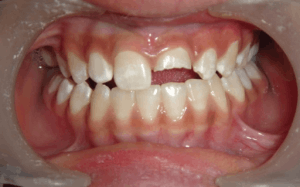Dental fracture
Background
Clinical Features

Ellis class III fracture on tooth 9
- Localized tooth fracture
- History of oral trauma
Differential Diagnosis
Evaluation
- Clinical diagnosis
- Consider obtaining panorex to evaluate for associated bone fracture
Management
Enamel (Ellis Class I)
- Routine follow up only; nothing to do
- May consider filing down sharp edges with an emery board for comfort
Enamel + dentin (yellowish) (Ellis Class II)
- Patients experience sensitivity to hot/cold stimuli and air passing over tooth during breathing
- Cover exposed dentin with calcium hydroxide to decrease pulpal contamination
- Next day follow up
Enamel + dentin + pulp (reddish) (Ellis Class III)
- On wiping fractured surface with gauze, blood is easily seen
- Immediate dental referral (dental emergency) - should be seen within 24 hours
- If not able to be seen immediately, cover exposed pulp with calcium hydroxide and dental cement.
- Discharge with penicillin or clindamycin as they have pulpitis by definition
Crown Root/Root fracture (not a common dental injury)
- Treatment for both is reduction, stabilization if fracture segment is stable and outpatient follow with dentist in 24-48 hours.
- If fracture segment unstable/very mobile may need to extract to prevent aspiration.
- Crown Root fracture does not always involve pulp vs root fractures almost always involves pulp.
Disposition
- Discharge with dental follow-up
See Also
External Links
Video
START_WIDGET6c35b7a2951071aa-0END_WIDGET
References
This article is issued from
Wikem.
The text is licensed under Creative
Commons - Attribution - Sharealike.
Additional terms may apply for the media files.